Author: Joseph L. DORRIS Date: 2014-9-13 19:57:34
The Pikes Peak region has beenproducing amazonite and smoky quartzspecimens as well as other pegmatiteminerals since the late 1870s. After a fewearlier experimental digs, the early1990s saw a couple of collectors beginningto use mechanized equipment to digbelow the old dug-out areas. Joe Dorrisfirst used a backhoe in 1993, diggingdownwards to 4 m. He had some limitedsuccess finding some remaining, undiscoveredmiarolitic cavities (pockets) inthe decomposed Pikes Peak granite.

Author with the freshly extracted first important specimen from the pocket known as “Two Pillars”. T. Dorris photo.
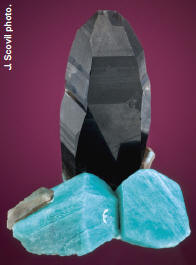
Classic combination of smoky quartz with amazonite from Lucky Monday pocket, Smoky Hawk claim, Colorado, USA. 8.2 cm in length. Spirifer collection
Beginning in 2000, Joe discoveredan extensive pegmatite swarm that heldan unusually high number of pockets. Hebrought out larger machinery, capable ofcrushing through the decomposed graniteto depths of 15 m to where some of thepockets were located. Many of the pocketscontained finely colored euhedral amazonite crystals in association withdeep black smoky quartz. This discoverybecame known as the Smoky Hawkstructure and has since produced manyof the world’s finest specimens.
The 2011 mining season tested JoeDorris’ mining company with brokenequipment and runaway costs. Both excavatorsbroke down, more than dou-bling their season’s expenses. But asluck would have it, they discovered whatmay end up being the best amazonitewith smoky quartz pocket ever found inColorado – the Lucky Monday pocket.
LOCALITY AND GEOLOGY
The Smoky Hawk claim is located inthe Pike National Forest, 32 km northwestof Pikes Peak, Colorado at an elevationof 2,725 m on a ridge aboveCrystal Creek.
Due to winter snow andice, access is limited to about sevenmonths a year. Mechanized operationsare significantly more limited due toground conditions and frequent electricalstorms that bring wind, heavy downpours,hail, and snow. Site access isthrough forest roads and a steep, fourwheeldrive road.
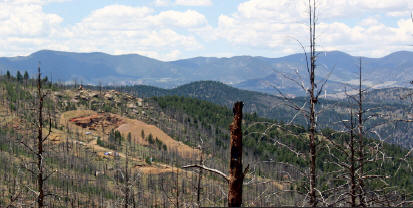
View of the Smoky Hawk claim. J. Dorris photo.
The Crystal Peak district is locatedwithin the Pikes Peak batholith (~1.07Ga, Mesoproterozoic era), which wasformed in a lengthy multistage processof several magma intrusions.
Today thePikes Peak batholith consists of threemain intrusive centers – Pikes Peak, LostPark, and Buffalo Park. Most of the CrystalPeak district is located within aslightly younger pluton known as theLake George ring complex on the northwestedge of the Pikes Peak intrusivecenter. This younger intrusion createdtensional fracturing acting as a conduitfor later-stage magma that formed pegmatite dikes. It is within these dikes thatthe miarolitic cavities occur. Today therocks that built the Lake George ringcomplex are more resistant to weatheringand form higher relief compared withsurrounding areas.
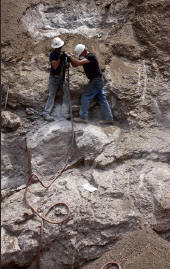

Drilling and blasting hard parts of the granite is sometimes necessery. P5M photo.
Although pegmatites intrudedthroughout the 3,100 km2 Pikes Peakbatholith, relatively few contain miaroliticcavities, and the majority that do,occur within the Crystal Peak district.
These pegmatites are classified withinthe NYF (Niobium-Yttrium-Fluorine) family of pegmatites. Their class and subclassare miarolitic, rare-earth element(MI-REE). The rare earth occurrenceshelp give rise to some of the more unusualminerals found such as, bastn?site-(Ce), xenotime, phenakite, cassiterite,monazite, rutile, and columbite-(Fe).

Map of North America showing inserts of the Pikes Peak area and the location of the Smoky Hawk claim.
Although over 60 mineral specieshave been found, those most commonare microcline, quartz, albite, biotite,zinnwaldite, fluorite, hematite andgoethite. Those most sought after by collectorsare amazonite (the blue-green varietyof microcline) with smoky quartz,and their associations with cleavelandite(the platy variety of albite), fluorite, andgoethite.
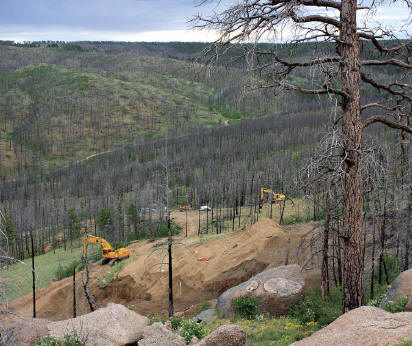
Workings at the Smoky Hawk claim. Ch. Borland photo.
SMOKY HAWKCLAIMPEGMATITES AND COLLECTING
In December of 1998, after 16 yearsof prospecting, the Smoky Hawk claimwas located. It is a standard 20 acre (approximately8 hectare) unpatented miningclaim in the Pike National Forest. Thearea was previously heavily hand dug byfield collectors, but it stood to reason byusing heavy equipment, deeper pocketsmight be found. Initial mechanizedprospecting began in 2000 and three good amazonite pockets were found in asubstantial pegmatite structure. Continuedexploration uncovered a system ofclosely related pegmatites and between2005 and 2010 a number of productivepockets were found and collected. In 2011, the pegmatite which eventuallyproduced the Lucky Monday pocket wasdiscovered.
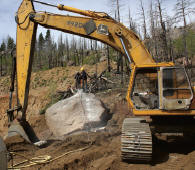
Mining at Smoky Hawk claim. P5M photo.
The miarolitic cavities discovered atthe Smoky Hawk are deceptively extensive,lens-like formations up to 90 by 60m. The pegmatites occur en echelon ,some within a meter of each other, andform a swarm of closely spaced andrelated pegmatites. Others are isolated.
They spread linearly from adjacent aplite or pegmatite dikes that developedalong more vertically oriented fracturesin the batholith.
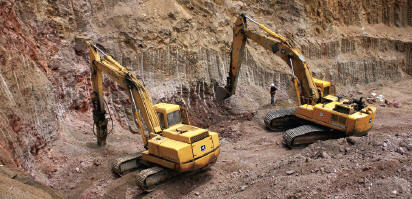
Two excavators used for mining at Smoky Hawk claim. Ch. Borland photo.
Typically, the pegmatite vein is relativelythin, ranging from 2 to 5 cm with aproducing pocket zone thickening to 30cm, rarely a meter. These thicker zonestend to surround a miarolitic cavity.











 YueGongAnBei 44051102000467
YueGongAnBei 44051102000467


 |
|